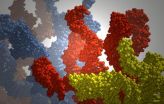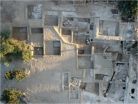(Press-News.org) Researchers from North Carolina State University have found a way to optimize the development of DNA self-assembling materials, which hold promise for technologies ranging from drug delivery to molecular sensors. The key to the advance is the discovery of the "Goldilocks" length for DNA strands used in self-assembly – not too long, not too short, but just right.
DNA strands contain genetic coding that will form bonds with another strand that contains a unique sequence of complementary genes. By coating a material with a specific DNA layer, that material will then seek out and bond with its complementary counterpart. This concept, known as DNA-assisted self-assembly, creates significant opportunities in the biomedical and materials science fields, because it may allow the creation of self-assembling materials with a variety of applications.
But, while DNA self-assembly technology is not a new concept, it has historically faced some significant stumbling blocks. One of these obstacles has been that DNA segments that are too short often failed to self-assemble, while segments that are too long often led to the creation of deformed materials. This hurdle can lead to basic manufacturing problems, as well as significant changes in the properties of the material itself.
A team of researchers from NC State and the University of Melbourne have proposed a solution to this problem, using computer simulations of DNA strands to identify the optimal length of a DNA strand for self-assembly – and explaining the scientific principles behind it.
"Strands that are too short or long form self-protected motifs," says Dr. Yara Yingling, an assistant professor of materials science and engineering at NC State and co-author of a paper describing the research. That means that the strands bond to each other, rather than to "partner" materials.
VIDEO:
These "dancing " DNA strands are part of a computer simulation showing the molecular dynamics trajectory of DNA strands that exhibit best efficiency for hybridization. It represents a significant advance in...
Click here for more information.
"The optimal lengths are not long enough to intertwine with each other, and are not short enough to fold over on themselves," Yingling explains. That leaves them exposed, and available to bond with the materials in another layer – the perfect situation for DNA self-assembly.
One potential application for such self-assembling materials is the development of drug-delivery vehicles. For example, researchers at the University of Melbourne have created self-assembling DNA capsules that are fully biocompatible, biodegradable and capable of releasing the drug when they come in contact with a specific physical stimulus – making them ideal for drug delivery.
DNA self-assembly technology is also expected to facilitate the creation of molecular sensors that use DNA to detect, and signal the presence of, clinically important biological molecules – which could have significant diagnostic applications in the medical field.
"We're now planning to explore additional factors that play a role in DNA self-assembly," Yingling says, "including temperature, genetic sequence and the environment in which the assembly takes place."
INFORMATION:
The paper, "Effect of Oligonucleotide Length on the Assembly of DNA Materials:
Molecular Dynamics Simulations of Layer-by-Layer DNA Films," was published online Oct. 12 by the journal Langmuir. Lead author of the paper is Abhishek Singh, a Ph.D. student at NC State. Co-authors include Yingling; former NC State post-doctoral research associate Dr. Stacy Snyder; and Drs. Frank Caruso, Lillian Lee and Angus Johnston of the University of Melbourne. The work was supported by funding from NC State and the Australian Research Council.
Researchers find 'Goldilocks' of DNA self-assembly
2010-10-29
ELSE PRESS RELEASES FROM THIS DATE:
Researchers generate iPSCs to further treatments for lung disease
2010-10-29
(Boston) A team of researchers from Boston University's Center for Regenerative Medicine and the Pulmonary Center have generated 100 new lines of human induced pluripotent stem cells (iPSC) from individuals with lung diseases, including cystic fibrosis and emphysema. The new stem cell lines could possibly lead to new treatments for these debilitating diseases. The findings, which appear in the current issue of Stem Cells, demonstrate the first time lung disease-specific iPSC have been created in a lab.
iPSCs are derived by reprogramming adult cells into a primitive stem ...
Algeo tracks evidence of 'The Great Dying'
2010-10-29
More than 251 million years ago, at the end of the Permian period, Earth almost became a lifeless planet. Around 90 percent of all living species disappeared then, in what scientists have called "The Great Dying."
Thomas J. Algeo, has spent much of the past decade investigating the chemical evidence buried in rocks formed during this major extinction. The University of Cincinnati professor of geology has worked with a team of scientific colleagues to understand the ancient catastrophe. Algeo will present his latest findings at the annual meeting of the Geological Society ...
Broad range of research presented to Geological Society of America
2010-10-29
A robust geoscience program will draw thousands of curious minds to the Colorado Convention Center in Denver for the 122nd Annual Meeting & Exposition of the Geological Society of America, Oct. 31 to Nov. 3. More than 3,700 technical presentations will illuminate geological and integrative science research of international, national and regional interest. Among the papers presented by University of Cincinnati faculty and students at the Geological Society of America annual meeting are:
China Anomalies Add To Permian Extinction Understanding
Our understanding of global ...
Penn study shows 2-sided immune cell could be harnessed to shrink tumors
2010-10-29
PHILADELPHIA - A recently identified immune cell that directs other cells to fight infection plays a critical role in regulating the immune system in both health and disease. Researchers from the University of Pennsylvania School of Medicine have discovered how a stimulatory molecule and a protein found on the membrane of another immune cell make T helper 17 cells multi-taskers of sorts. Th17 cells protect the body against infection and cancer, but are also culprits in some autoimmune diseases and out-of-control, cancerous cell growth.
This new understanding that Th17 ...
The unhealthy ego: What can neuroscience tell us about our 'self'?
2010-10-29
With Election Day right around the corner, political egos are on full display. One might even think that possessing a "big ego" is a prerequisite for success in politics, or in any position of leadership. High achievers–CEO's, top athletes, rock stars, prominent surgeons, or scientists–often seem to be well endowed in ego.
But when does a "healthy ego" cross the line into unhealthy territory? Where is the line between confident, positive self-image and grandiose self-importance, which might signal a personality disorder or other psychiatric illness? More fundamentally, ...
Scientists investigate evolution of new polio virus
2010-10-29
The virus, called enterovirus 71, is closely related to poliovirus, and was first detected in California in the 1960s. Since then the virus has spread across Asia, affecting mostly children and some adults. Serious cases of the disease can include neurological disorders such as meningitis, paralysis and encephalitis.
As a result of a global health campaign, polioviruses have almost been eradicated in many areas of the world. Enterovirus 71, however, has caused major outbreaks of hand, foot, and mouth disease and it is still unclear why such a high number of cases occur ...
Paradise lost -- and found
2010-10-29
Ancient gardens are the stuff of legend, from the Garden of Eden to the Hanging Gardens of Babylon. Now researchers at Tel Aviv University, in collaboration with Heidelberg University in Germany, have uncovered an ancient royal garden at the site of Ramat Rachel near Jerusalem, and are leading the first full-scale excavation of this type of archaeological site anywhere in the pre-Hellenistic Levant.
According to Prof. Oded Lipschits and graduate student Boaz Gross of Tel Aviv University's Department of Archaeology, this dig is an unparalleled look into the structure ...
Study identifies flaws in Medicare prescription drug program
2010-10-29
Millions of Medicare recipients have been forcibly reassigned to different prescription drug plans because Part D reimbursements to insurance companies covering low-income patients are lower than the actual costs incurred, according to a study released online today by Health Affairs. The report describes how a system designed to encourage competition and to subsidize care for low-income Medicare patients instead has led companies to raise their premiums in an effort to price themselves out of the low-income segment of the Part D market.
"These insufficient payments create ...
U of M researchers identify possible key to treating, understanding post-traumatic stress disorder
2010-10-29
MINNEAPOLIS / ST. PAUL Minn. (October 28, 2010) – University of Minnesota Medical School and Minneapolis Veterans Affair Medical Center researchers have discovered a correlation between increased circuit activity in the right side of the brain and the debilitating, involuntary flashbacks triggered by post traumatic stress disorder (PTSD).
The ability to objectively diagnose PTSD through concrete evidence of neural activity, its impact and its manifestation is the first step towards effectively helping those afflicted with this severe anxiety disorder.
PTSD often stems ...
Found: First complete remains of early sauropod dinosaur
2010-10-29
Boulder, CO, USA - Scientists have discovered in China the first complete skeleton of a pivotal ancestor of Earth's largest land animals – the sauropod dinosaurs. The new species, tentatively dubbed Yizhousaurus sunae, lived on the flood plains around Lufeng in the Yunnan Province of South China about 200 million years ago. The species helps explain how the iconic four-footed, long-necked sauropod dinosaurs evolved.
Unlike the 120-foot-long, 100-ton sauropod giants that came later, Yizhousaurus was about 30 feet in length, but it shows all of the hallmarks of later sauropods: ...



